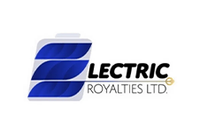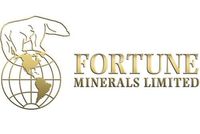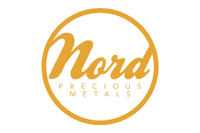First Cobalt Intersects High Grade Mineralization at Iron Creek
First Cobalt Corp. (TSXV:FCC, OTCQX:FTSSF, ASX:FCC) (the “Company”) is pleased to announce drill results from its Iron Creek Cobalt Project in Idaho, USA. Results reported today highlight a high grade zone at the western extent of the current Inferred Resource, which remains open along strike and at depth.
First Cobalt Corp. (TSXV:FCC, OTCQX:FTSSF, ASX:FCC) (the “Company”) is pleased to announce drill results from its Iron Creek Cobalt Project in Idaho, USA. Results reported today highlight a high grade zone at the western extent of the current Inferred Resource, which remains open along strike and at depth.
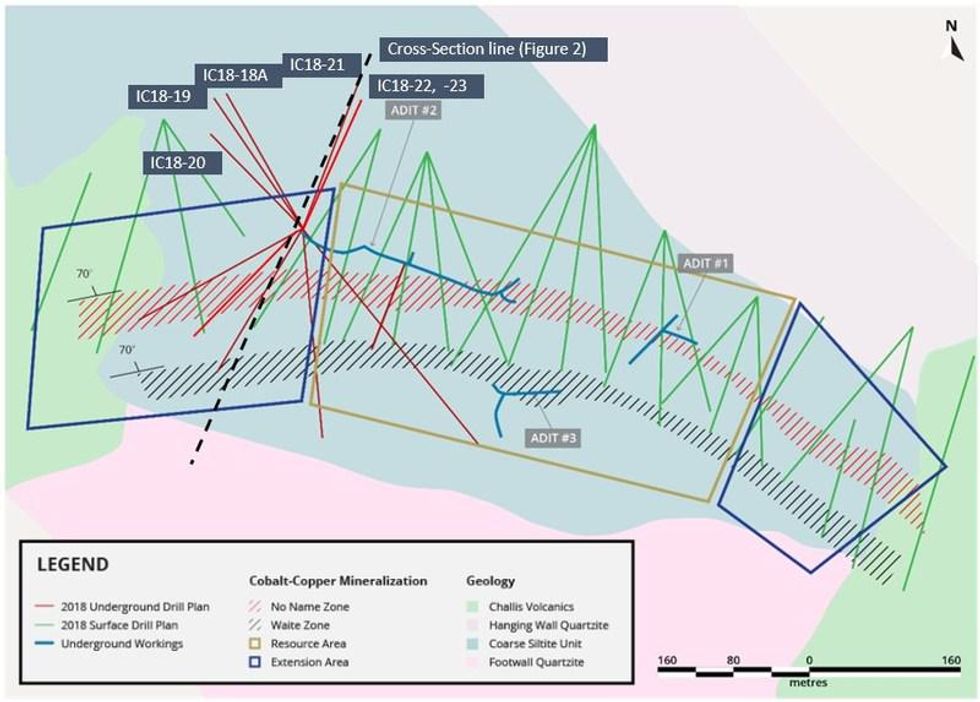
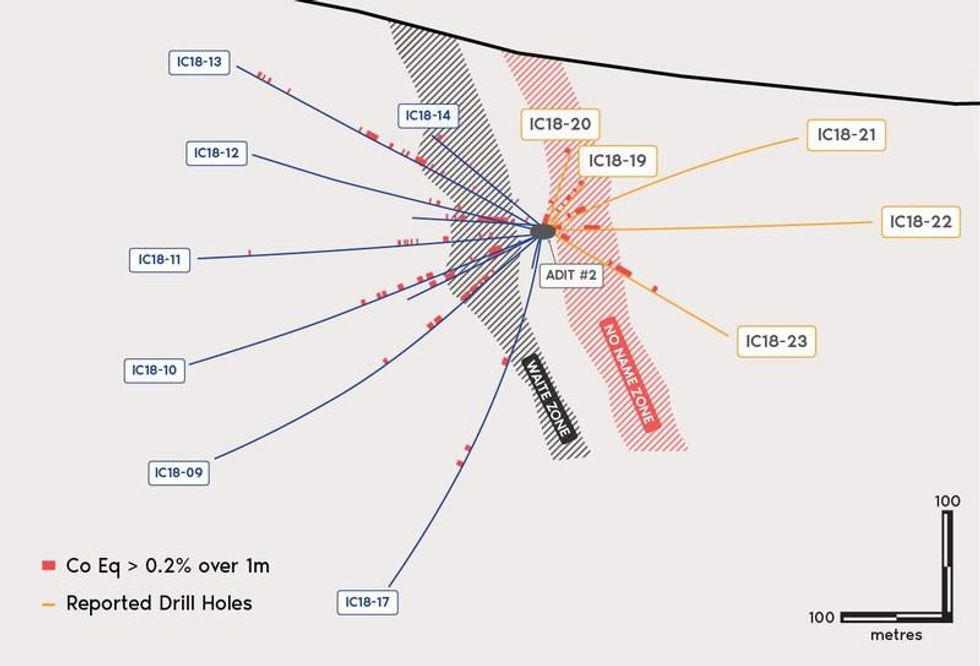

Highlights
- Drilling confirms cobalt and copper metal zonation, including higher grade copper and cobalt zones
- High grade copper (Cu) intercepts include 10.0m of 4.04% Cu and 8.0m of 3.16% Cu, including 1.4m of 6.56% Cu and 20.5 g/t Ag; cobalt (Co) intercepts include 1.04% Co over 1.5m and 0.51% Co over 4.1m
- Cobalt remains the dominant resource metal with higher grade cobalt zones towards the eastern extent of known mineralization and copper-rich zones to the west
- Higher grade copper and cobalt zones within broader zones of mineralization provide optionality for development
- Third drill rig expected on site in October and Company will undertake a bore-hole geophysical survey to potentially identify extensions of known mineralization as well as new targets
Trent Mell, President & Chief Executive Officer, commented:
“High grade cobalt and copper zones within wider mineralized zones, such as those reported here, expand our options for development as we look to the future of this project. As work advances, I am repeatedly impressed by the increasing potential of this resource and look forward to updating our mineral resource estimate in early 2019 with results from the ongoing program.”
Underground drilling from the western extent of Adit#2 targeting the No Name Zone has outlined a discrete higher grade copper zone within broader zones of mineralization. The broader zones are outlined in the Inferred Resource estimate reported September 26, 2018. These high grade intersections characterize distinct cobalt and copper mineralized zones, which have been observed to overlap in some areas (Table 1, Figure 3).
Table 1. Assay Results
| Hole ID | From
(m) |
To
(m) |
Drilled
Length (m) |
True
Width (ft) |
True
With (m) |
Cobalt
% |
Copper % | CoEq
% |
| IC18-18A | 0.0 | 7.3 | 7.3 | 4.1 | 1.2 | 0.62 | 0.02 | 0.62 |
| IC18-18A | 97.0 | 104.8 | 7.8 | 7.9 | 2.4 | 0.23 | 3.69 | 0.60 |
| including | 101.5 | 104.8 | 3.3 | 3.3 | 1.0 | 0.43 | 8.00 | 1.23 |
| IC18-18A | 192.9 | 219.8 | 26.9 | 26.2 | 8.0 | 0.01 | 3.16 | 0.33 |
| including | 205.4 | 210.0 | 4.6 | 4.6 | 1.4 | 0.01 | 6.56 | 0.67 |
| IC18-19 | 0.0 | 7.9 | 7.9 | 13.4 | 4.1 | 0.51 | 0.04 | 0.51 |
| IC18-19 | 20.4 | 27.0 | 6.6 | 13.4 | 4.1 | 0.02 | 2.42 | 0.26 |
| IC18-19 | 45.4 | 64.6 | 19.2 | 32.9 | 10.0 | 0.01 | 4.04 | 0.42 |
| IC18-20 | 0.0 | 5.8 | 5.8 | 10.2 | 3.1 | 0.39 | 0.03 | 0.40 |
| IC18-20 | 40.7 | 47.8 | 7.1 | 13.0 | 4.0 | 0.01 | 2.87 | 0.30 |
| IC18-21 | 0.0 | 1.5 | 1.5 | 4.9 | 1.5 | 1.04 | 0.40 | 1.08 |
| IC18-21 | 18.0 | 22.6 | 4.6 | 14.8 | 4.5 | 0.01 | 4.85 | 0.50 |
| IC18-22 | 0.0 | 2.1 | 2.1 | 6.0 | 1.8 | 0.62 | 0.75 | 0.69 |
| IC18-22 | 5.2 | 6.7 | 1.5 | 4.3 | 1.3 | 0.11 | 1.53 | 0.27 |
| IC18-22 | 18.6 | 29.7 | 11.2 | 31.3 | 9.5 | 0.03 | 2.31 | 0.26 |
| IC18-23 | 0.0 | 11.3 | 11.3 | 14.9 | 4.6 | 0.26 | 0.95 | 0.36 |
| IC18-23 | 42.1 | 56.8 | 14.8 | 22.6 | 6.9 | 0.05 | 1.45 | 0.20 |
| Results reported above, other than drill holes IC18-21 and -22, were included in the Inferred Resource estimate reported September 26, 2018. Cobalt equivalent is calculated as %CoEq = %Co + (%Cu/10) based on US$30/lb Co and US$3/lb Cu. No metallurgical recoveries were applied to either metal as it is expected that the metallurgical recoveries will be similar for both metals. Flotation tests support the Company’s opinion that both cobalt and copper are of sufficient grade to be recovered. True thickness estimated from 3D geological model also considering drill holes on strike. |
Intersections in each hole characterize a cobalt-rich to copper-rich transition with copper grades higher than those previously reported. These results are specifically encouraging to advance drilling along the western strike extent ahead of infill drilling in the central portion of the resource near Adit#1.
Throughout the Iron Creek mineralized zones, copper grade strongly correlates with silver. High grade copper samples, those greater than 4%, were found to contain silver greater than 10 g/t. High grade copper intercepts reported here from hole IC18-18A include 8.00% Cu and 19.4 g/t Ag over 1.0m true width within 2.4m of 3.69% Cu and 6.56% Cu and 20.5 g/t Ag over 1.4m true width within 8.0m of 3.16% Cu.
Previous drilling at the western extension was primarily from surface. Underground access provides a better vantage point for testing the western strike extent and the vertical extent of both the No Name and Waite mineralized zones. Intersections from horizontal drill holes are at appropriate angles to determine true widths of mineralization.
The higher grade copper mineralization can be correlated between holes along strike and down-dip (Figure 2). Drill hole IC18-18A intersects the No Name Zone 50m further west from the other five holes reported here, indicating the higher-grade copper mineralization associated with cobalt extends along strike. Holes previously drilled southward from the same station in the Waite Zone showed cobalt-copper mineralization extends along strike at this horizon (see press release dated July 19, 2018). Mineralization was also intersected below this horizon that may reflect a thickening of this zone or represents another zone in the stratigraphic footwall.
Copper mineralization typically occurs with cobalt in both the No Name and Waite Zones, but these six holes have intersected copper as semi-massive chalcopyrite lenses, each up to 0.5m drilling widths. The copper-rich lenses are concentrated toward the upper portion of the No Name Zone. Associated higher grade cobalt mineralization is prevalent in the lower portion of the No Name Zone. Higher grade copper also occurs in the western portion of the Waite Zone, but is currently encountered by only a few drill holes.
Disseminated pyrite is also present with chalcopyrite and results show it is also generally cobalt-bearing as found throughout the Iron Creek resource. This transition has been previously noted in prior drill hole assays and in sampling from Adit#1, but the metal zoning is enhanced in this western portion. Further drilling from surface is planned in this area to continue testing the western strike extent.
Assay data was modelled from 62 drill holes (excluding holes IC18-21 and -22) outlining the continuity of cobalt mineralization across the strike length of the drilled area (Figure 3). Higher grade copper mineralization had been previously recognized around Adit#1, but a larger zone has now been identified (shown in red, Figure 3) at the western extent of Iron Creek. Higher grade cobalt is prominent in the eastern extent of the drilled area (shown in blue, Figure 3) suggesting a metal zonation. This zonation is commonly seen in other hydrothermal deposits containing cobalt and copper and may be predictable, therefore it may be a useful exploration guide for further drill targeting.
Preliminary floatation tests have indicated a separate copper concentrate could potentially be produced so copper-rich mineralization could be processed separately to ensure high quality source feed. Today’s results show a sizeable strike extent of higher-grade copper that warrants specific attention for future mine development planning.
Next Steps
Drilling is ongoing to extend the strike length of the mineralized zone from 450 metres to over 1,000 metres and test down dip extensions of known cobalt-copper zones from 150 metres to over 300 metres below surface.
A bore-hole geophysical survey will also start later this month intended to identify extensions of known mineralization to define new drilling targets. The survey will also characterize magnetic and electro-magnetic properties of mineralization to be used in future airborne and ground surveys in 2019.
Iron Creek Property
First Cobalt announced on September 26, 2018 an Inferred Resource estimate at Iron Creek of 26.9 million tonnes grading 0.11% cobalt equivalent (0.08% Co and 0.30% Cu containing 46.2 million pounds of cobalt and 176.2 million pounds of copper) under a base case scenario pit constrained and deeper mineral resource. An alternative underground-only scenario results in 4.4 million tonnes grading 0.23% Co and 0.68% Cu (0.30% CoEq) using a cutoff underground grade of 0.18% CoEq and containing 22.3 million pounds of cobalt and 66.7 million pounds of copper. The Inferred Resource is based on drilling over a strike length of approximately 500 metres and a dip extent of over 150 metres.
The Iron Creek property consists of patented mining claims surrounded by unpatented mining claims covering an area of 1,698 acres. Significant infrastructure is in place to support multiple drills and underground activity. Historic underground development includes 600 metres of drifting in three adits and an all-weather road connecting the project to a state highway.
Cobalt-copper mineralization occurs largely within two distinct east-west trending zones. The No Name and Waite Zones are roughly parallel and dip roughly 75° to the north, remaining open at depth and open along the east and west strike extensions. The No Name Zone and the Waite Zone have true widths between 10m and 30m. Mineralization also occurs between the No Name and Waite Zones as 1m to 5m pods.
Preliminary metallurgical testing concludes that simple flotation methods are applicable, yielding recoveries of 96% for cobalt and 95% for copper in rougher floatation.
Cobalt-copper mineralization occurs as semi-massive and disseminated pyrite and chalcopyrite along stratabound bands within finely layered meta-sedimentary rocks consisting of interbedded argillite and quartzite. Thin veins of sulfide minerals also cut the bands and meta-sedimentary rocks. Quartzite units make up the hangingwall and footwall to the mineralized meta-sedimentary horizon. This stratigraphic sequence has been mapped at surface and by drilling to extend along strike for at least two kilometres.
The principal mineral assemblage consists of pyrite, chalcopyrite, pyrrhotite, and magnetite with much lesser quantities of native copper and arsenopyrite locally. Scanning-electron and microprobe tests indicate the cobalt occurs largely or entirely within pyrite and there is a distinct lack of cobaltite, a common cobalt ore mineral containing arsenic. Drill results demonstrate that the cobalt and copper mineralization are in part separated from each other spatially, and in part overlapping.
Quality Assurance and Quality Control
First Cobalt has implemented a quality control program to comply with industry best practices for sampling, chain of custody and analyses. Blanks, duplicates and standards are inserted at the core processing site as part of the QA/QC program. Samples are prepared and analyzed by American Assay Laboratories (AAL) in Sparks, Nevada. Over 15% of the samples analyzed are control samples consisting of checks, blanks, and duplicates inserted by the Company; in addition to the control samples inserted by the lab. Drill core samples are dried, weighed crushed to 85 % passing -6 mesh, roll crushed to 85% passing -10 mesh, split 250 gram pulps, then pulverized in a closed bowl ring pulverizer to 95 % passing -150 mesh, then analyzed by a 5 acid digestion for ICP analysis. All samples have passed QA/QC protocols.
Qualified and Competent Person Statement
Dr. Frank Santaguida, P.Geo., is the Qualified Person as defined by National Instrument 43-101 who has reviewed and approved the contents of this news release. Dr. Santaguida is also a Competent Person (as defined in the JORC Code, 2012 edition) who is a practicing member of the Association of Professional Geologists of Ontario (being a ‘Recognised Professional Organisation’ for the purposes of the ASX Listing Rules). Dr. Santaguida is employed on a full-time basis as Vice President, Exploration for First Cobalt. He has sufficient experience that is relevant to the activity being undertaken to qualify as a Competent Person as defined in the JORC Code.
About First Cobalt
First Cobalt is a vertically integrated North American pure-play cobalt company. First Cobalt has three significant North American assets: the Iron Creek Project in Idaho, with Inferred mineral resources of 26.9 million tonnes grading 0.11% cobalt equivalent; the Canadian Cobalt Camp exploration project and the only permitted cobalt refinery in North America capable of producing battery materials.
On behalf of First Cobalt Corp.
Trent Mell
President & Chief Executive Officer
Neither TSX Venture Exchange nor its Regulation Services Provider (as that term is defined in policies of the TSX Venture Exchange) accepts responsibility for the adequacy or accuracy of this release.
Cautionary Note Regarding Estimates of Resources
Readers are cautioned that mineral resources are not economic mineral reserves and that the economic viability of resources that are not mineral reserves has not been demonstrated. The estimate of mineral resources may be materially affected by geology, environmental, permitting, legal, title, socio-political, marketing or other relevant issues. The mineral resource estimate is classified in accordance with the Canadian Institute of Mining, Metallurgy and Petroleum’s “2014 CIM Definition Standards on Mineral Resources and Mineral Reserves” incorporated by reference into NI 43-101. Under Canadian rules, estimates of inferred mineral resources may not form the basis of feasibility or pre-feasibility studies or economic studies except for Preliminary Economic Assessment as defined under NI 43-101. Readers are cautioned not to assume that further work on the stated resources will lead to mineral reserves that can be mined economically. An Inferred Mineral Resource as defined by the CIM Standing Committee is “that part of a Mineral Resource for which quantity and grade or quality are estimated on the basis of limited geological evidence and sampling. Geological evidence is sufficient to imply but not verify geological and grade or quality continuity. An Inferred Mineral Resource has a lower level of confidence than that applying to an Indicated Mineral Resource and must not be converted to a Mineral Reserve. It is reasonably expected that the majority of Inferred Mineral Resources could be upgraded to Indicated Mineral Resources with continued exploration.”
Cautionary Note Regarding Forward-Looking Statements
This news release may contain forward-looking statements and forward-looking information (together, “forward-looking statements”) within the meaning of applicable securities laws and the United States Private Securities Litigation Reform Act of 1995. All statements, other than statements of historical facts, are forward-looking statements. Generally, forward-looking statements can be identified by the use of terminology such as “plans”, “expects’, “estimates”, “intends”, “anticipates”, “believes” or variations of such words, or statements that certain actions, events or results “may”, “could”, “would”, “might”, “occur” or “be achieved”. Forward-looking statements involve risks, uncertainties and other factors that could cause actual results, performance and opportunities to differ materially from those implied by such forward-looking statements. Factors that could cause actual results to differ materially from these forward-looking statements are set forth in the management discussion and analysis and other disclosures of risk factors for First Cobalt, filed on SEDAR at www.sedar.com. Although First Cobalt believes that the information and assumptions used in preparing the forward-looking statements are reasonable, undue reliance should not be placed on these statements, which only apply as of the date of this news release, and no assurance can be given that such events will occur in the disclosed times frames or at all. Except where required by applicable law, First Cobalt disclaims any intention or obligation to update or revise any forward-looking statement, whether as a result of new information, future events or otherwise.
For further information: visit www.firstcobalt.com or contact: Heather Smiles, Investor Relations, info@firstcobalt.com, +1.416.900.3891
Source: www.newswire.ca
